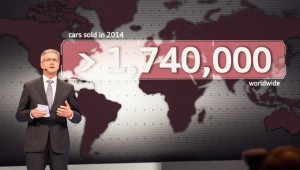
Audi's Board of Management Chairman Rupert Stadler highlights the fact the brand sold 1.74 million units globally in 2014.
Audi enjoyed another record year in 2014, selling more than 1.74 million vehicles globally – a 10.5% jump – with auto powerhouses China and the U.S. leading the sales charge.
The result bested the company’s predictions by nearly 500,000 units. Audi saw sales in China rise 17.7% and jump 15.2% in the U.S., which were the biggest increases of any of the countries where Audi sells vehicle with one exception: Brazil. The German maker nearly doubled sales in the country, where it sold fewer than 9,000 units in 2013.
“We delivered more in 2014 than promised,” said Board of Management Chairman Rupert Stadler. “After a very positive start to this year, we aim to achieve a new record for unit sales in 2015.”
Through the first two months, Audi appears to be on track to meet that goal; however, it’s going to require the long-term trend of rising sales in the U.S. will need to continue. Between 2009 and 2014, sales increased from 82,716 units to 182,011 last year. Sales have increased for 50 consecutive months, according to Audi. Another accolade is only likely to help that streak continue.
The Audi A3 and Q3 have been named to Kelley Blue Book’s 10 Best Luxury Cars under $35,000 list for 2015. The list recognizes vehicles with exceptional standard equipment, fuel economy and performance.
“The 2015 A3 and Q3 raise the bar for what is to be expected in terms of standard performance and technology in the entry premium market,” said Scott Keogh, president, Audi of America. “This unwillingness to compromise on the amenities that drivers value most is reflected by the recognition from KBB.”
Part of Audi’s appeal in the U.S. is that buyers feel like their getting a high-end luxury vehicle at a fair price, in particular for the A3.
“Entry-level does not have to mean a major compromise,” KBB.com noted. “This sedan is small but well equipped, peppy and comfortable. It’s also the only one in its segment to offer an optional diesel engine.”
While the Q5 is the best‑selling Audi model in the United States, rising sales of entry-level sedans and compact SUVs and crossovers are the fastest growing segment now, which bodes well for Audi.
(Audi powers up the R8 e-tron, takes aim at Tesla. For more, Click Here.)
While the U.S. helped to drive sales, the slow down of auto sales in China apparently had no impact on Audi whatsoever and it’s continuing into 2015. The long‑wheelbase version of the A6 is the best‑selling premium car in China, with sales increasing by 18.9% to 10,168 units in February.
Overall, Audi sales increased 4.2% in February, but the month was shortened due to the Chinese New Year celebrations. In the first two months, Audi delivered 84,960 premium cars in China, 10.5% more than one year ago.
(Click Here for details the latest Audi Prologue concept.)
Selling vehicles at a record clip is important, but profitability is the ultimate measure. Audi lived up to the hype in 2014: revenue of more than €50 billion, operating profit exceeding €5 billion, operating return on sales of 9.6%.
(To see more about the possibility of VW killing off the Beetle, Click Here.)
By 2020, Audi intends to expand its product range from the current 52 to 60 models. At the Annual Press Conference, Board of Management Member for Technology Ulrich Hackenberg explained, “The new models Audi Q7, Audi R8 and Audi A4 are the highlights of our model initiative in 2015.” The company will continue to thrill its customers worldwide with pioneering technologies and progressive automobiles with the sporty Audi DNA.

Audi’s primary sales gains in the U.S. are from adding models – which has not worked for VW. Many consumers view Audi models as similar in status to a BMW with what some believe is a nicer interior. Just as with styling, all of this is subjective.
When the magazines hand out awards those who are status conscious tend to gravitate towards the models with bragging rights. Between Audi’s marketing, awards and model variations, they have continued to maintain slow growth but realistically they are only a niche player in the U.S. market with annual sales of ~200K vehicles. If not for sales in China, many auto makers would be hurting for profits.